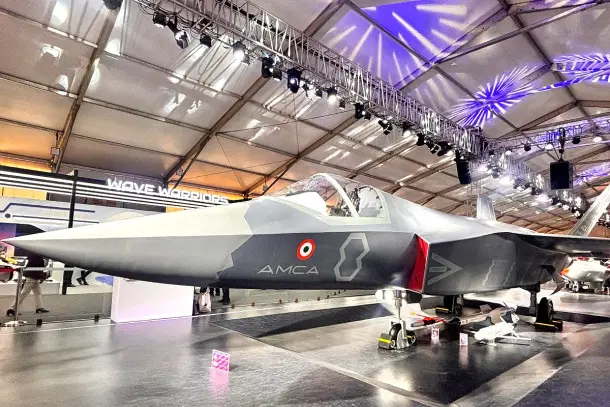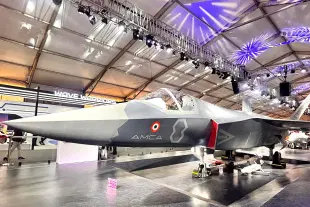News Brief
India's AMCA Stealth Fighter Programme Enters New Phase As MoD Approves 'Execution Model'—Here's The Lowdown
Swarajya Staff
May 27, 2025, 12:09 PM | Updated 03:48 PM IST
Save & read from anywhere!
Bookmark stories for easy access on any device or the Swarajya app.


The Ministry of Defence (MoD) has approved a public-private partnership model for the execution of the stealth fifth-generation Advanced Medium Combat Aircraft (AMCA) programme.
Defence Minister Rajnath Singh has cleared the execution model, which allows both public and private Indian companies to bid independently, form joint ventures, or operate as consortia.
The Aeronautical Development Agency (ADA) will lead the programme and is expected to issue an Expression of Interest (EoI) for the development phase soon. The selected bidder must be an Indian entity in compliance with national laws and regulations.
A committee led by Defence Secretary Rajesh Kumar Singh, comprising members from the Indian Air Force and Hindustan Aeronautics Limited (HAL), is currently evaluating private sector participation models. These models include joint ventures with HAL or independent private involvement in design and development.
HAL, which currently outsources substantial work to private firms such as L&T, Godrej, and Azad Engineering, will continue to play a significant role. The Tata Group, which works with Airbus on the C-295 aircraft assembly in India, is among the private firms with relevant experience.
Advanced Medium Combat Aircraft
The AMCA is envisioned as a twin-engine, all-weather, multirole stealth fighter, positioning India among an elite group of nations—currently including the US, China, and Russia—capable of developing fifth-generation aircraft.
Designed for air superiority, ground strikes, suppression of enemy air defenses, and electronic warfare, the AMCA features advanced systems tailored for modern combat. Its stealth profile incorporates a low radar cross-section, achieved through radar-absorbent materials and internal weapons bays, enabling it to evade enemy detection.
It can carry weapons internally weighing up to 1.5 tonnes and can also operate in non-stealth mode by mounting weapons on its wing stations.
The aircraft will feature an Active Electronically Scanned Array (AESA) radar, sensor fusion, and a smart cockpit with integrated decision aids—enhancing pilot situational awareness and autonomy. Its supercruise capability enables sustained supersonic flight without afterburners, offering significant advantages in fuel efficiency and tactical engagement.
Furthermore, the AMCA will integrate with unmanned combat aerial vehicles for manned-unmanned teaming, aligning with evolving global combat doctrines.
With a maximum takeoff weight of 25 tons, a length of 18 meters, and a wingspan of 11.13 meters, it surpasses existing IAF fighters like the Su-30MKI. It is capable of reaching speeds up to Mach 1.8 and operating at a ceiling of 55,000 feet.
Some descriptions even classify it as a 5.5-generation fighter, indicating capabilities beyond current fifth-generation standards.
The aircraft will be powered by the US-based GE F-414 engine, which will be co-produced in India. It will have 75 percent indigenous content, which is expected to be scaled up to 85 percent in later phases.
Development Timeline
The AMCA’s development timeline reflects both ambition and the inherent complexity of building a fifth-generation fighter. Feasibility studies began in 2009, with formal government sanction granted in March 2024.
The preliminary design phase is complete, and a full-scale model was unveiled at Aero India 2025, confirming the completion of the Critical Design Review by the IAF.
Initially, the first prototype was expected to fly by 2026–27, but recent updates suggest this may be delayed to 2028–29. The programme aims to produce five prototypes. Certification is targeted for 2032, with induction into the Indian Air Force planned for 2034.
DRDO Chairman Samir V. Kamat has indicated that development trials will conclude by 2034, though potential delays remain, particularly in propulsion development.
Some reports suggest that the government plans to establish two parallel assembly lines—one public and one private—to mitigate production delays.
To meet the timeline, GE and HAL have already started preparations to produce the F-414 engine in India, ensuring it is ready for integration with the AMCA airframe. Prior to the AMCA, the F-414 engine will power the Light Combat Aircraft (LCA) Tejas Mk-2. A prototype of the LCA Mk-2 is expected to roll out by the end of this year.
The LCA Mk-2, intended to replace the IAF’s Mirage 2000s and Jaguars, is scheduled for its maiden flight in 2026, according to ADA Director General Jitendra J. Jadhav.
Trump’s Offer of F-35 Fighters
In February 2025, during Prime Minister Narendra Modi’s visit to Washington, D.C., US President Donald Trump offered to sell India the F-35 stealth fighter. This offer has sparked debate within India’s defence circles over its implications.
Although Defence Secretary Rajesh Kumar Singh confirmed that a formal proposal is yet to be received from Washington, he stated that the government would consider it with an “open mind” once it is made.
This proposal has introduced complexity into the AMCA’s trajectory. Acquiring the F-35 could divert funding and focus from the indigenous programme, potentially delaying or scaling back its development. However, some see the F-35 as a temporary solution to bolster IAF capabilities until the AMCA is operational. This view is gaining traction, especially considering that the Pakistan Air Force may soon acquire Chinese stealth fighters.
Opponents of the F-35 deal argue that the cost of purchasing and maintaining a limited number of F-35s is prohibitively high, citing the Rafale deal with France’s Dassault Aviation as a more balanced approach.
Supporters counter that infrastructure investment for a few F-35 squadrons should not be viewed as an added cost but as a strategic investment to prepare the IAF for a smooth transition to AMCA squadrons in the 2030s and 2040s.





